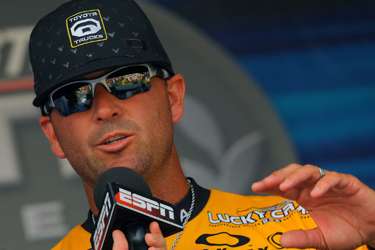
Docks + shade = bass That’s the simple equation Gerald Swindle likes to work whenever he fishes any lake in the fall that has floating boathouses or fixed piers. “It’s real effective in the fall because fish are going back shallow, and the lakes are the clearest they’ll be all year,” says Swindle.
“The lakes are also starting to draw down, and, with the water level falling, there’s not as much cover up shallow. So the boat docks offer shade and are automatic hiding places for bass feeding up for winter.” The Alabama pro knows bass will be roaming in the backs of shallow bays in the morning, but when the sun gets higher, the fish move under the docks along the adjacent shallow flat.
“My ideal dock in the fall should be no deeper than 4 feet in the front and then the back would actually be touching the bank or maybe 10 inches deep,” says Swindle, who also prefers isolated cover. “I don’t necessarily like 20 docks in a row.
I like just two or three docks together.” Another key to finding the right dock is to look for floats covered with algae growth, which attracts baitfish and sunfish. When he finds an ideal dock for skipping, Swindle like to “slice the pie” and divide the dock into different sections. “If there is a fish in the front of the dock and you throw all the way to the back and catch a 4-pounder and it comes slicing out, you may run three out that won’t bite then,” warns Swindle.
“So I start at the front and work towards the back and constantly look for the biggest shadow, which is where I will make some of my last casts without trying to make any racket. I am always looking for the largest shadow under the dock.” Positioning his boat about 12 to 15 feet away from the dock, Swindle can skip his lure under the decking to reach the darkest spots of the boathouse.
He skips with a 7-foot medium-heavy Quantum Smoke PT rod, which has a fast tip and micro guides for smoother casting and better accuracy, and a Quantum Smoke PT baitcast reel (6.3:1 gear ratio) with its adjustable centrifugal brake system that allows him to place the lure in hard-to-reach places without backlashing. “I can skip with a spinning rod, but the baitcaster allows me to be so much faster, and I can put on bigger line (17- to 20-pound Vicious Fluorocarbon) and manage it,” he says. “When you get to that size line on a spinning reel, everything is a mess.
There’s going to be more line at your tennis shoes than there is under the dock.” The 11–time Bassmaster Classic qualifier believes skipping with baitcast equipment is easier than most anglers think. “What you really want to work on is the roll cast and the wrist,” says Swindle. “Hold your rod with your bait down at 6 o’clock and make a full circle with the rod. When you get back to 6 o’clock, release the lure.
You want your rod tip pointing right to where you want your bait to land, whether it’s a small crack in the foam or between two wooden posts.” As soon as the spool stops spinning, Swindle engages the reel to prepare for any quick strikes from bass chasing the skipping lure. His favorite lure combo for skipping under docks is a brown 3/8-ounce Arkie jig and a green pumpkin Zoom Fat Albert twin-tail plastic grub.
He favors the Fat Albert as a jig trailer because it skips well across the surface, and, once submerged, the lure’s dual tails generate a lot of action. “If it seems like the fish are active, I skip it to a big shadow, keep my rod tip up and swim it back real slow,” says Swindle.
The swimming retrieve works best for Swindle on cloudy days. When the sun is shining and the dock is casting a large shadow, the Elite Series pro hops his jig-and-grub combo along the bottom of the shaded area.
Editor’s Note: If you have a story idea you would like to vote on for an upcoming poll, send your idea to john@jnoutdoors.com.





